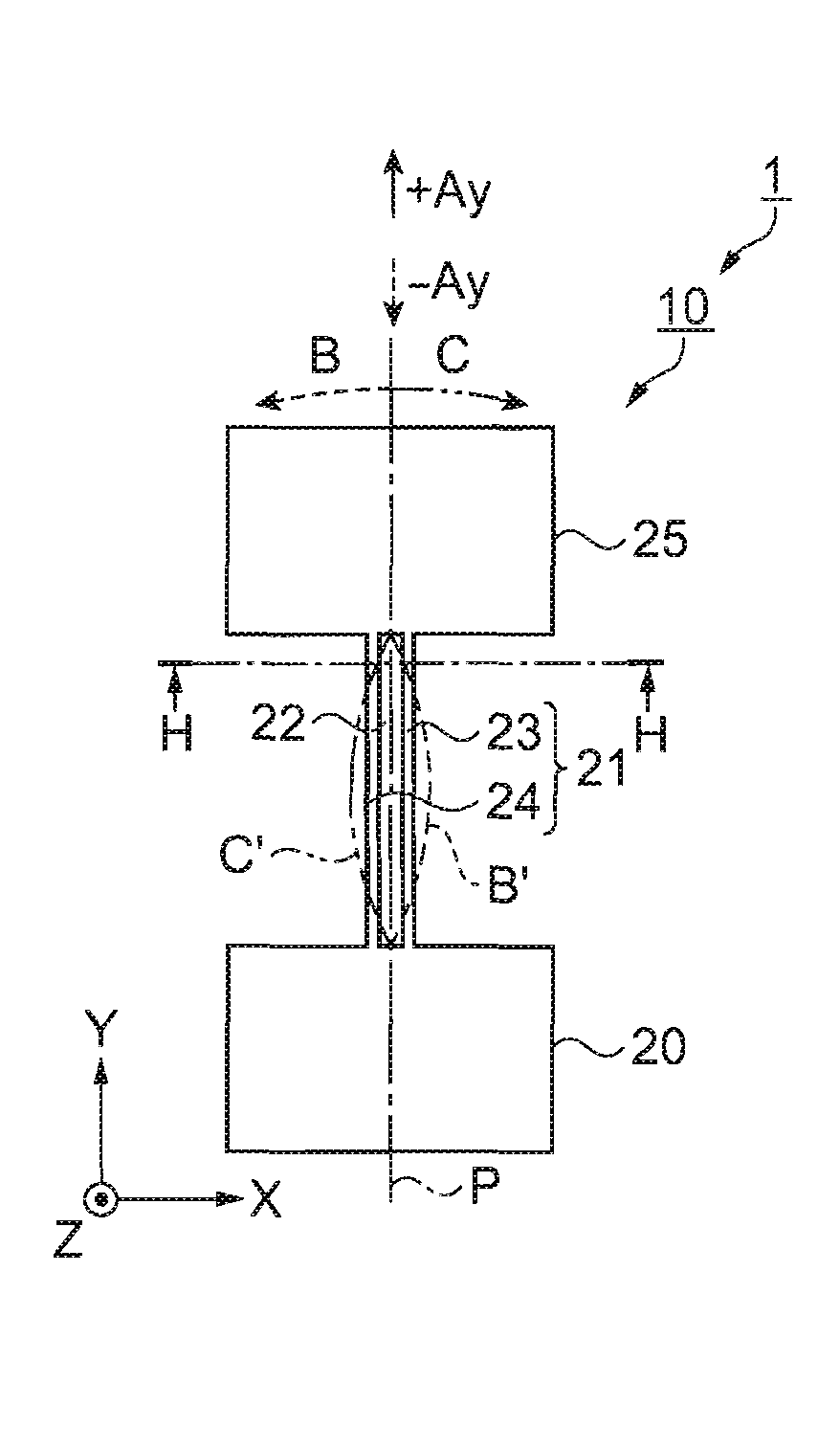Acceleration Sensor
- Summary
- Abstract
- Description
- Claims
- Application Information
AI Technical Summary
Benefits of technology
Problems solved by technology
Method used
Image
Examples
first embodiment
[0071]FIGS. 1A and 1B show an example of an acceleration sensor according to the first embodiment, where FIG. 1A is a front elevational view thereof, and FIG. 1B is a sectional view of a section H-H in FIG. 1A. Referring now to FIG. 1A, an acceleration sensor 1 is formed with a vibrating body 10 that includes: a base 20 anchored to an un-illustrated pedestal; and an oscillating arm 21 extended out like a beam from the side surface of the base 20 and oscillates transversally in a planer direction at a predetermined resonant frequency.
[0072]The vibrating body 10 is formed with a piezoelectric material. Piezoelectric materials may include materials such as lead titanate (PbTiO3), lead titanate zirconate (PZT; registered trademark), zinc oxide (ZnO), and quartz. This embodiment exemplifies the usage of high-Q quartz that excels in temperature-frequency characteristics.
[0073]The vibrating body 10 is formed with a z-cut expanding in an x-y plane, and the oscillating arm 21 thereof extends...
first modification
[0096]An acceleration sensor according to a first modification of the first embodiment will now be described with reference to drawings. The first modification is peculiar in that the vibrating body has a single anchor structure and oscillates linearly and transversally. FIG. 2 is a perspective view illustrating a structure of the acceleration sensor according to the first modification. Referring to FIG. 2, the vibrating body 10 functioning as an acceleration sensor has the same configuration as that of the first embodiment (refer to FIGS. 1A and 1B), except for the added mass 25. The detection unit 35 is provided as an extension of the oscillating arm 21, and the through hole 22 divides the vibrating arm 21 into the oscillating blocks 23 and 24.
[0097]The excitation electrodes 31 to 34 shown in FIGS. 1A and 1B are disposed on the lateral surfaces of the oscillating blocks 23 and 24. If the oscillation circuit inputs excitation signals to the excitation electrodes 31 through 34, wher...
second modification
[0104]An acceleration sensor according to a second modification of the first embodiment will now be described with reference to drawings. The second modification is peculiar in that the free end of the oscillating arm is provided with an added mass which allows the linear and transversal oscillation. Components that are different from that of the aforementioned first embodiment (refer to FIGS. 1A and 1B) will mainly be described. Like reference numerals designate like structure in the first embodiment.
[0105]FIG. 4 is a front elevational view illustrating a vibrating body according to this modification. Referring to FIG. 4, the vibrating arm 21 of the vibrating body 10 extends vertically in the y-axis direction as a beam, from the center of one side of the base 20. A through hole 22 is opened in the center of the width direction (x-axis) of the vibrating arm 21, extending along longitudinal direction (y-axis), penetrating through in the thickness direction (z-axis).
[0106]The through ...
PUM
 Login to View More
Login to View More Abstract
Description
Claims
Application Information
 Login to View More
Login to View More - R&D
- Intellectual Property
- Life Sciences
- Materials
- Tech Scout
- Unparalleled Data Quality
- Higher Quality Content
- 60% Fewer Hallucinations
Browse by: Latest US Patents, China's latest patents, Technical Efficacy Thesaurus, Application Domain, Technology Topic, Popular Technical Reports.
© 2025 PatSnap. All rights reserved.Legal|Privacy policy|Modern Slavery Act Transparency Statement|Sitemap|About US| Contact US: help@patsnap.com



